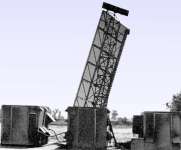AN/TPS-32
Description of the radar set, tactical-technical characteristics

Figure 1: AN/TPS-32
| Specifications | |
|---|---|
| frequency: | 2 905 … 3 080 MHz
(S-Band) |
| pulse repetition time (PRT): | 1 090 … 3 772 µs |
| pulse repetition frequency (PRF): | |
| pulsewidth (τ): | 30 µs |
| receive time: | |
| dead time: | |
| peak power: | 2.2 MW |
| average power: | |
| instrumented range: | 300 NM (≙ 556 km) |
| range resolution: | 800 m |
| accuracy: | 229 m; 0.5° |
| beamwidth: | 2.15° |
| hits per scan: | |
| antenna rotation: | 6 rpm |
| MTBCF: | |
| MTTR: | |
AN/TPS-32
The AN/TPS-32 is a helicopter-transportable, long-range, three-dimensional, computer-controlled, S-Band radar. The radar set includes the Primary Radar, SSR, VHF/UHF/HF Ground to Air Communications, Power Conditioning System, Processing and Display System, Voice and Data Recording System. The transmitter can vary the interpulse period and peak power to better illuminate targets at long-ranges and lower elevations. The AN/TPS-32 Radar Set is composed of three equipment shelters and a pedestal mounted antenna array.
The antenna is a horizontally polarized frequency scanning phased array that electronically stears the beam in elevation. Subdividing a long pulse into five sub-pulses of differing frequencies creates five overlapping elevation beams that are step-scanned as a group through a −1° to +18° range. Each beam is 0.84º high and 2.15º wide. The antenna gain is at least 41 Decibels, and the side lobes at least 25 Decibels below the peak of the main beam. The antenna is collapsible onto three pallets for movement.
The radar came in service in the US Marine Corps in 1969, and is retired from service. Turkey’s sets were adapted for use within the NATO Air Defense Ground Environment (NADGE) system and designated AN/TPS-64.

